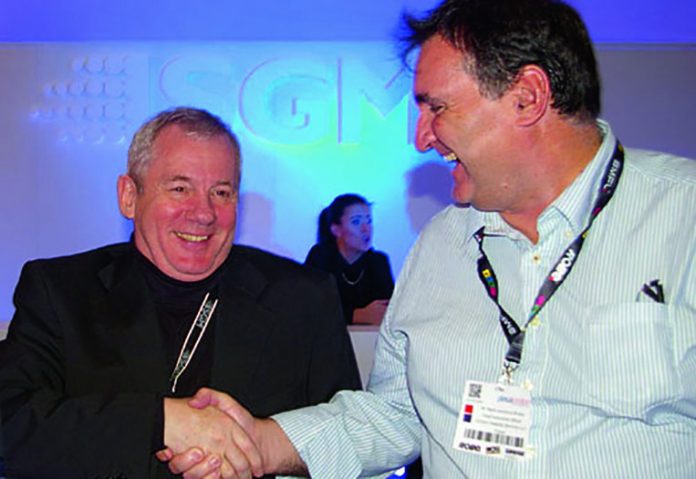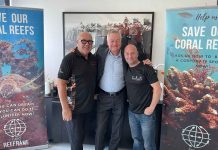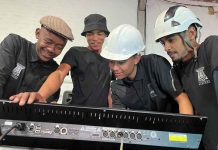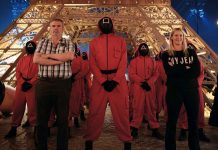In the early days of entertainment technology, Mark Brown’s ‘can-do’ attitude made him stand out from the crowd. Since then, he has amassed a wealth of experience, allowing him to stay at the forefront of the events industry for over 25 years. Entertainment technology writer and PR guru Jerry Gilbert interviews Mark with affection reflection to discuss his career – from his first move into the industry with Tangerine Productions, providing lasers for HRH Prince Edward’s 21st birthday party, through to his move to Dubai, where he is now the Group Chairman for eclipse Staging Services…
When Mark Brown noticed me among the refugees in the EasyJet holding area at Amsterdam’s Schiphol Airport, trudging back, booze-weary and visually maxed out from the 2005 ISE Show, he shouted across the concourse that he and his travelling companion, Richard Wright, had just bought a company.
And so it happened that I found myself handling PR for the company concerned – the LED manufacturers, Unitek. This was typical Mark behaviour. Boosting technology resource through acquisitions of this nature may have become Mark’s stock-in trade this side of the millennium, but in our respective earlier guises – way back in the mid-80s – I had handed him the gong for Laser Grafix’s stupendous Prisma laser system at a gala event. Then in the Spring of 1991, I had also showcased the equally outré Starlaser system on the front cover of a magazine I was about to launch. This depicted Deep Purple’s Richie Blackmore proudly performing under a bold new hybrid-combining laser with conventional lighting.
The fact that Starlaser’s chequered life started with Deep Purple and ended with The Chippendales (via an Elton John tour) could be seen as a metaphor for Mark Brown’s own journey through the industry.
Love him or hate him, the world of entertainment technology would have been a poorer place without Mark Brown and his relentless ‘can-do’ attitude. In the farrago of early eccentrics who became the frontiersmen of our industry, Mark quickly stood out. The first time I met him, he was dressed in the authentic Darth Vader outfit that he had somehow managed to procure from 20th Century Fox after arriving at the Bloomsbury Crest Hotel’s Langham Suite for BADEM’s Discotek 82 show. He was there to promote his London-based multi-faceted sales operation, Laser Video – a company set up in the early days of threegun overhead projectors, and with the misguided belief that the laserdisc would shortly take over the world. Among the cornucopia of new was also the Laserscience laser show, I recall.
As a laserist, he connects right back to the Godfather of the genre, John Wolff at Holoco, as well as his long-term friend, Andy Holmes at Laserpoint, whom he first met back in 1979.
But the story begins with Tangerine Productions, which he set up at the tender age of 18. At their Shepperton Studios base, Holoco had produced the heavily-synthed – and lasered – television advert for a new beer that Allied Breweries were launching called Arctic Lite. Now, Allied wanted to take the real thing on tour – and when Mark won a deal to tour hundreds of nightclubs and northern WMCs, he contracted Laserpoint to provide the lasers.
Air-cooled 100mW argon lasers and Minimirror scanning went out to any venue with a 300+ capacity across the Tetley and Ansell’s estate – rising to 4W water-cooled lasers for the bigger venues. From there, Mark was up and running with an operation that offered everything from bubble machines to DJs, hospitality girls and all technical equipment. This was partying on steroids!
“However, it was always lasers that was the real fascination for me,” he admitted. And, by the early ‘80s, he had set up Laser Video, running the operation out of Hampstead.
Early successes included installing the high-profile Pink Elephant ‘fun houses’ for Adrian Webb’s Showstoppers. The first of these was a conversion of the famous Royalty soul haven in Southgate to be followed soon after in Luton, where the equally legendary Caesar’s Palace was transfigured. In February 1983, Laser Creations, with whom Mark was working, installed the 4W krypton argon laser in Luton while Laser Video specified the Barco overhead projector, JVC monitor, Hitachi VCR and the fashionable CEL Chromascope processor – a typical package during the first days of professional video in clubs. Around the same time, Laser Video also provided kit for Vince Power’s landmark, Mean Fiddler, in north west London.
Mark worked with Andy Holmes at Cambridge-based Laserpoint (setting up Laserpoint London from his Hampstead base, and sub-contracting to Laser Systems), and then with Chris Matthews at Laser Creations. But, it was during the giddy days of the disco boom in the latter half of the 1980’s, after taking over Laser Grafix, that he really made his mark – at a time when every self-respecting nightclub owner believed that £20K worth of laser, the ultimate club owner’s manhood expletive, would pimp the club’s offer into the stratosphere.
Laser Grafix were to influence some of Europe’s most iconic venues – replacing old laser technology at London flagships, The Hippodrome and Camden Palace.
During that time, his company conjoured up several dramatic Lazarus-style comebacks. “It was full of peaks and troughs and the company had to reincarnate itself on three occasions, much to my embarrassment,” Mark admitted. A comment once made to me by the father of a famous laserist, stating that his son was either as rich as Croesus or as poor as a church mouse, couldn’t have rung more true.
“The truth is I stuck with lasers for too long. They were always the cherry on top of the cake after the essentials – lighting, sound, and video – but they were a high-cost investment and in addition to the capital outlay, they required a plumber, an electrician, optical, hardware and software development engineers.”
And so, after nearly two decades in an industry that had been built brick by brick by pioneers and fellow Prometheans, Mark was about to make a major step chain. And it was with a wry smile that we learnt that he had ended the old millennium by heading off to Dubai to set up Laser Grafix there.
Yet, setting foot in the Emirates, and establishing the predominant event rental company, eclipse Staging Services in 2003, the furrow he has ploughed has remained straight and true.
The Royal Banquet
Okay, so if that’s a snapshot of Mark Brown’s early career, let’s fill in some important detail. Although needing to comply with the notorious ‘PM19’ – the Health & Safety Guidance Note governing safe use of lasers for display purposes – the burgeoning nightclub scene, inspired since 1973 by Ivan Dryer’s Laserium and later by German company Tarm’s spectacular displays, had been ever eager to embrace the new technology during those transformative days of the early-to-mid 1980s.
After selling lasers for events – firstly with Andy Holmes at Laserpoint and later as an employee of the new Laser Creations – 1985 was to see a personal highlight when Mark was selected to provide lasers for HRH Prince Edward’s 21st birthday party at Windsor Castle, having become the latter’s laser effects provider when he was running the May Ball Committee for Jesus College, Cambridge.
The entire UK Royal Family, including HRH Princess Diana and Prince Charles were present, in addition to Jackie Stewart and Anouska Hempel. HRH Queen Elizabeth II was so impressed with his work that she invited Mark and his wife to join her for lunch on the day of Live Aid at Windsor Castle with Charles and Edward to show her appreciation.
But he had become disillusioned by the time he was approached the following year by John Campbell, another former Laserpoint man. John had set up Laser Grafix in Royston in 1985, along with Gerry Leitch, Lorraine Ludman and Chris Matthews’ brother, Dave, and Laser Grafix needed a salesman. Having now worked with most of the UK’s leading laser specialists, he knew his reputation was on the line.
Mark had acquired some capital through a property sale and realised it was a cash injection that Laser Grafix needed before focusing on a sales operation. “So I reached an agreement to take over the lion’s share of the business.”
But there was soon a split among the hierarchy before the company settled down under Mark’s stewardship and entered a period of stability. In its later heyday, Chris Rolph, who was with the Royston company from mid-1989 to 1995, was selling lasers into clubs at a prodigious rate – and their engineering specialists Gino and Ram Malocca were on permanent installation duty out on the club circuit. In addition to Camden Palace and the Hippodrome, they also installed lasers for Equinox Leicester Square for First Leisure and Fabrice Emaer’s outrageously camp theatre, Le Palace in Paris (another legendary venue like Camden, that had been given a major makeover by Tony Gottelier). And, as First Leisure advanced into Europe with a nightclub in Zandaam, Holland, they also bought into the revolutionary system.
Camden replaced its white light laser in time for Christmas 1990. “It was the first full-colour Purelight installation with the new beam table and Laser Grafix Prisma system,” Chris Rolph remembered. This was installed in the lighting booth next to Axon Digital’s equally groundbreaking new DMX Oska lighting desk.
Why had Prisma become so successful? Mark is in no doubt: “Laser Grafix were not only working with the Purelight laser head but also Lasermedia’s graphics control system, based on the Acorn Archimedes, which we redesigned to become Prisma; this had also been the graphics engine driving the Tarm lightshows.” As far back as 1986, the industry was being wowed by Lasermedia’s presentation using Ghostbusters modules to illustrate the superiority of their animated laser effects with flicker-free logos.
“Lasermedia had phenomenal graphics and Prisma delivered that quality but with a live tactile controller so you could operate it live. Every major club wanted one,” said Mark.
“If I had my life over again, although I would still have done lasers, I would have got out quicker. I realised much later that I had needed to diversify.”
And when he did diversify, in 1990, it was another massive play – although it still involved lasers. Equally significant was the fact that it introduced him to Martin Lubach, who two years ago became eclipse Staging Services’ General Manager.
“Martin was development technician for Tasco, working with the Starlite moving head – the only alternative to Vari-Lite at that time. I had been invited to a party at Tasco HQ and remember that [Tasco MD] Joe Browne needed something to differentiate himself,” recalled Mark.
Starlaser was the result – a hybrid moving light and laser forced down a single projector barrel. Starlite had been a Tasco subsidiary and funding for the project was achieved through 3i venture capital before the operation was purchased by Dave Snipp and Ray French, along with Brown, under the newly named Starlite Systems Technology.
“I owned it with them for a grand total of nine weeks,” recalled Mark. “But since they didn’t really need a salesman they bought out my interest. It was a fantastic product but I had already fallen out with Joe Browne and was fairly depressed with the whole situation.”
Subsequently, a similar light and laser combination called Nexus, which was engineered to go into High End Systems Intellabeam, was still born. Picaresque stories abound as to the reasons why, but Mark believes it followed an incident in a popular local industry restaurant in Rimini during the SIB Show, after which he operated under the sobriquet of ‘Ice Bucket Brown’ for several years.
Laser Grafix’s final show of 1999 was the laser used for the River of Fire opposite the BA London Eye – turned on by Tony Blair and one of the four best international news shots for the start of the new millennium. By this time, though, Mark was in Dubai.
THE MOVE TO DUBAI
Over in the Gulf, Mark would replace his old laser chums with an accomplished band of fellow emigrés. The person largely responsible for Mark setting up a new base in Dubai was Simon Ransom, who at the time was GM for Gearhouse Dubai – the company set up by Steve Lakin in the mid-90s. In 1999, Laser Grafix were hired by Simon for a high-profile event. The visit also put him back in contact with former colleague, Lorraine Ludman, who was running DLC Dubai (a diminution of the Definitive Laser Company that she had helped to set up after leaving Laser Grafix).
Having left Gearhouse, which had gone through several iterations before being taken over by PRG, Simon undertook project director roles of unimaginable proportions – often pulling in Laser Grafix and later eclipse. Aside from his role as Technical Director of KAUST (King Abdullah University of Science and Technology), he was heavily involved in the celebrated launch of Atlantis Resort Hotel at the Palm Jumeirah, as well as the UAE 40th National Day celebration with eclipse, which took place on a monstrous scale, with macro projections at the twin sites of the Grand Mosque and Al Jahili Fort in Abu Dhabi. Meanwhile, Laser Grafix / eclipse also claimed the FIFA World Congress and the launch of Dubailand among their credits.
Mark also worked with Adrian Bell, who had run the Vari-Lite Production Services’ Middle East office in Dubai (1998-99) before it was acquired by Steve Lakin under his new Protec operation. After Protec, Adrian and Mark worked in LED installations and media management systems.
Another important figure in the process leading to the formation of eclipse was Peter McCann. He had become MD of Gearhouse Arabia, which was subsequently sold in 2014 to become PRG Gearhouse. Needing a Western supply company, it was he who recommended Mark set up a rental company. The final piece in the jigsaw was Morten Carlsson (owner of Procon MultiMedia), an original Starlite customer, who had also shown interest in Starlaser. “Without him eclipse would never have got off the ground,” noted Mark. Both Adrian and another old name from the past, Andy Holmes, along with Mark, thus became founding directors of the new eclipse Staging Services in 2003.
Andy was also to be a catalyst in the brief takeover of Unitek Displays Ltd and Unitek Holdings Ltd by Mark and former Laserpoint man, Richard Wright, two years later – in the Spring of 2005. This was an opportunity to push further into the LED display business after Mark had made his LED baptism by supplying a Gearhouse Optoscreen, one of the first of the genre, to Star City in Birmingham. The company had been owned by Richard and Graham Nye, whose background had been in LED road signs and who had no real appetite to remain in the entertainment industry, believes Mark.
“I funded a company with Brett Salmon, a former Laser Grafix employee who had an office in China – and this had resulted in me giving Unitek a major order for a town square in Nanjing,” said Mark. Unitek’s original rental business had been sold to Creative Technology, but they had invested in CRT projection technology. “And I don’t think had realised how big LED would become in rentals,” he continued. “They did a deal to take on the rental side of the business for five years, leaving Unitek free only to manufacture and sell; I had come in towards the end of that five-year exclusion period.” And the focus of Unitek’s sales mission was largely shopping centres.
It should have been a match made in heaven but Mark was soon forced to place the company into liquidation after the non-fulfillment of several high profile deals – including a prospective arrangement with Formula One chief Bernie Ecclestone in which Mark had invested enormous faith. However, this fell through after a meeting set up at the Belgium Grand Prix was aborted.
During this period, Adrian had been fronting eclipse, but Mark felt the Dubai company was starting to turn more into a production company, rather than a rental one and therefore in danger of competing with its own customers. The two men had different ideas about how the company should be positioned, and so Mark bought out his partner’s stake. Today he is CEO and chairman of the eclipse Group.
With Darren Hodge doing a sterling job as eclipse’s General Manager prior to Martin Lubach’s arrival, the CEO sensed they needed to build up inventory. “We didn’t have much equipment so I went to Martin Professional to help and they gave me favourable credit terms. We bought great products like the MAC 2000 the LC 2140 Plus LED panels and MAC Vipers. But we felt Martin Professional lost their way a bit after that and Clay Paky started bringing out great products like Alpha Beam 1500, Sharpy / SuperSharpy and now Mythos. Christie has also been extremely supportive so we have also invested heavily in them.”
Looking at their inventory today, by whatever metric you use, eclipse Staging Services has grown to become one of the largest in-house suppliers of audiovisual rental in the Middle East. With itsrecently-acquired d&b PA rig, it now have full capability in lighting, video and sound, as well as full staging capabilities – all of which were on show at the recent Dubai Music Week.
Today, its fleet includes more than 30 front-line audio consoles, 650 loudspeakers and amplifiers, over 100 lighting consoles and 1,500 each of intelligent and conventional lighting fixtures, as well as 80 high powered projectors, more than 1,000 LED tiles and enough pyro and special effects to stage productions on the largest scale – with all the necessary infrastructure.
To harness the growth, this summer, the company added to its existing facility in Dubai Investment Park (DIP), taking possession of six additional warehouses located adjacent to the current site, effectively tripling both warehouse and workspace capacity.
Strategic acquisitions
But it has been the past two years that has really seen the acceleration go into overdrive, with a number of strategic acquisitions and partnerships – superintended by a group staff roster now touching 140 personnel.
Last month, eclipse Staging Services announced the signing of a landmark rental partnership with Faber Audiovisuals whereby it will act as the exclusive Middle East rental partner for the European provider of LED screens. It had already bought Nocturnal Communications from sound specialist, Nick Chapman, when the latter wanted to return to South Africa. “This gave us radio communications and mules, the all terrain vehicles which helps onsite logistics with sound and lighting,” said Mark.
Meanwhile, Mark’s stepson, Arran Hopkins, who was running Laser Grafix, had been moving further into special effects, working with Sameer Rahman who subsequently set up Flair SFX & Production with eclipse as its partner. This growth also resulted in the investment in another special effects company, Stage FX, which was already operating in the regional market providing large-scale effects for both indoor and outdoor events. “We now have a majority of the special FX market in the Middle East,” declared Mark.
In fact, Laser Grafix has remained active throughout – with a UK operation in Bedfordshire, which is run by Mark’s brother-in-law Toby MacKnight. The company has recently developed the Starbeam laser (a throwback to the old ‘Star’ prefix), which has been out on a number of high-profile tours.
Meanwhile, another member of the Brown family dynasty, daughter Jemma Joy, is Special Assistant to Simon Ransom, who took on the role of Group COO in 2013 after working as a management consultant to Mark for the previous two years. “I wanted her to understand the business from the floor up,” said Simon. “She has the education and the knowledge of the client side to be a great asset and she is the heir apparent! With Mark approaching 60, we needed her to be an integral part of the business continuity plan.”
Another recent but already successful start-up has been eclipse Venue Services, , which provides a unique 24/7 on-site technical support for hotels and venues. “This has grown quickest – three months ago we had two venues and now we are at eight venues contracted,” said Mark. “This was intended to make us the largest player in this region.”
However, one initiative that Mark had been so positive about when I’d met him in Dubai back in 2012 was the prospect of setting up bases across the UAE to serve the growing markets. “But in the end we decided against it and I’m glad we did,” he admitted. “The market hit the skids during the terrible property collapse, from 2009-11, and although we prospered through it, the volume of business in Saudi, Kuwait and Qatar can be serviced equally well from here.”
Perhaps it’s a sign of the times that Mark’s supreme passion for lasers is now equalled by his passion in investment in education for future generations. “It’s my chief ambition,” he confirmed. “We have completed an internship partnership with Rose Bruford, SAE and the University of South Wales – and now have six interns working with us.
“We have also partnered with EMDI [Dubai’s EMDI Institute of Media and Communication] to provide its students with an introduction to the technical and business side of the live events industry and are sponsors of the Eventice competition alongside the Event Show. We were able to offer two jobs to successful applicants due to the high level of proficiency, placing one in eclipse Venue Services and the other in eclipse Staging Services.”
This investment in the next generation workforce is already paying off, as eclipse Staging Services Project Manager, Tom Ralston, has already been named the Middle East Event Industry’s Young Achiever for 2014. Mark himself won Outstanding Contribution to the event industry in the region, while eclipse Staging Services were named the Middle East Event Industry’s Employer of the Year 2015.
But there is no sign of complacency and his mission today doesn’t stop there.
In his drive to make eclipse an increasingly ethical and environmentally aware company, Mark is taking every opportunity to raise standards generally across the region. To exemplify this, the eclipse Group is the first event industry technical production company to employ a full time, NEBOSH-qualified in-house Group Health, Safety and Environment Manager, to promote a positive health and safety culture throughout the businesses.
Hardly surprisingly, this activity has resulted in a 30% year on year increase in turnover – or to enumerate it by Simon Ransom’s metric, “In the last five years we have quadrupled the size of our turnover and our margins and profit have followed. We have gone from two companies to five and one of these will grow 60% this year.”
Will there be any let up in 2016? Not if Mark has any say, with his ‘can-do’ attitude. “We’re now looking at pushing out into the installation market,” he confirmed, as if this remains the final frontier. But this also comes spiked with caveats. “Next year we can expect the general climate to be more challenging. Local banks say the allowance for bad debt provision is rising, the price of real estate is uncertain and the oil price remains an issue,” he said with foreboding.
But with the wise head of his COO, Simon – together with processes and procedures espoused by General Manager Martin Lubach, from his days at Essential Lighting and later PRG – there are steady hands on the eclipse tiller. In other words some of that old Mark rogue energy is today firmly harnessed.
And with age, Mark himself has naturally replaced the cavalier persona with the corporate. “I’m still loving what I’m doing but I’m coming up to 60 and I’m told I should start to slow down a bit,” he admitted. But despite the succession plan, given the eclipse Group’s present momentum, it would be brave man who bets on Mark applying the brakes any time soon.




